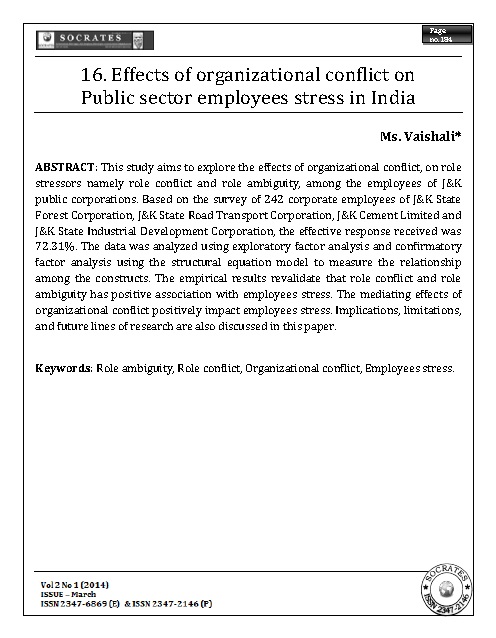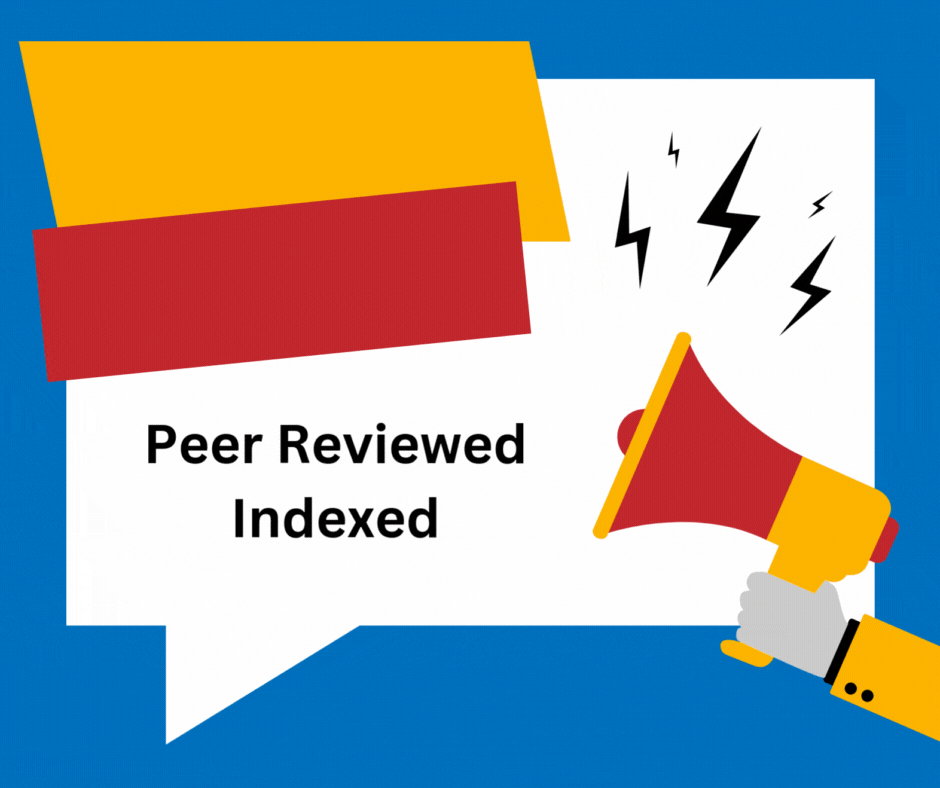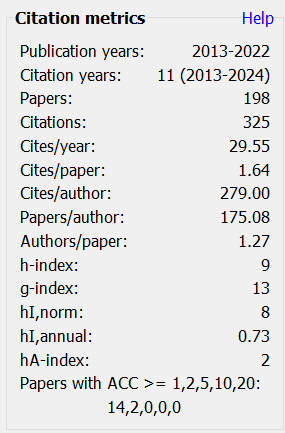Effects of organizational conflict on Public sector employees stress in India
Keywords:
Role ambiguity, Role conflict, Organizational conflict, Employees stressAbstract
This study aims to explore the effects of organizational conflict, on role stressors namely role conflict and role ambiguity, among the employees of J&K public corporations. Based on the survey of 242 corporate employees of J&K State Forest Corporation, J&K State Road Transport Corporation, J&K Cement Limited and J&K State Industrial Development Corporation, the effective response received was 72.31%. The data was analyzed using exploratory factor analysis and confirmatory factor analysis using the structural equation model to measure the relationship among the constructs. The empirical results revalidate that role conflict and role ambiguity has positive association with employees stress. The mediating effects of organizational conflict positively impact employees stress. Implications, limitations, and future lines of research are also discussed in this paper.
Downloads
Metrics
References
King Saud University: Admin sciences.11(2).pp.135-170.
Ashforth, B.E. & Lee, R.T. (1990). Defensive behavior in organizations: a preliminary model. Human Relations. 43. pp. 621-48.
Babin, B.J.& Boles, J.S. (1996). The effects of perceived co-worker involvement and supervisor support on service provider role stress, performance and job satisfaction. Journal of Retailing. 72(1). pp.57-75.
Bagozzi, R.P. (1980). Causal Models in Marketing, New York: Wiley.
Bentler, P.M. & Bonnet, D.G. (1980). Significance tests and goodness-of-fit in the analysis of covariance structures. Psychological Bulletin.88(3).pp.588–606.
Conley, S. & Woosley, S. A. (2000). Teacher role stress, higher needs and work outcomes. Journal of Educational Administration. 38(2). pp. 179-201.
Corwin, R. G. (1961). Role conception and career aspirations: A study of identity in nursing. Sociological Quarterly. 2. pp. 69-86.
Cronbach, L. (1951). Coefficient alpha and the internal structure of tests. Psychometrical.16 (3). pp.297–34.
Cryer, B., McCraty, R. & Childre, D. (2003). Pull the plug on stress. Harvard Business Review. 81.pp. 102-107.
Darling, J.R. & Fogliasso, C.E. (1999). Conflict management across cultural boundaries: A case analysis from a multinational bank. European Business Review.99 (6). pp. 383-392.
De Dreu, C. K.W. & Van Vianen, A. E.M. (2001). Responses to relationship conflict and team effectiveness. Journal of Organizational Behavior. 22. 309 – 328.
Dodd, D. (2003). The Importance of Portal Strategy was Computing. Website: www.computing.co.uk. Last retrieved: 12-12-2013.
Dua, J. K. (1994). Job stressors and their effects on physical health, emotional health and job satisfaction in a University. Journal of Educational Administration. 32. pp.58-78.
Elloy, D.F., Terpening W. & Kohls, J. ( 2001). A causal model of burnout among self managed work team members. Journal of Psychology.135. pp.321-335.
Friedman, R., Tidd, S., Currall, S. & Tsai, J., (2000). What goes around comes around: The impact of personal conflict style on work conflict and stress. International Journal of Conflict Management.11. pp. 32-55.
Gardner D.B. & Cary A. (1999). Collaboration, conflict, and power: lessons for case managers. Family & Community Health. 22, pp. 64-77.
Georgopoulos, B. & F. Mann (1962). The Community General Hospital, New York: Macmillan.
Gilboa, S., Shirom, A., Fried, Y. & Cooper, C. (2008). A meta-analysis of work demand stressors and job performance: Examining main and moderating effects. Personnel Psychology.61. pp.227-271.
Gillespie, N. A., Walsh, M., Winefield, A. H., Dua, J., & Stough, C. (2001) Occupational stress in universities: staff perceptions of the causes, consequences and moderators of stress. Work & Stress. 15. pp. 53-72.
Gonzalez-Roma, V.& Lloret, S. (1998). Construct validity of Rizzo et al.’s (1970) role conflict and ambiguity scales: A multisample study. Applied psychology: An International Review.47(4), pp.535-545.
Hair, J.F., Anderson, R.E., Tatham, R.L.& William, C.B. (2006). Multivariate Data Analysis. Pearson Education, Inc.U.K.
Henry, Ongori (2009). Organisational conflict and its effect on organisational performance. Research Journal of Business Management. 2(1). pp.16-24.
Hobman, Elizabeth V.; Bordia, Prashant & Gallois, Cynthia (2003). Consequences of feeling dissimilar from others in a work team. Journal Of Business And Psychology.
17(3). pp.301-325.
Hoel, Helge &Giga, Sabir I. (2006). Destructive interpersonal conflicts in the workplace: The effectiveness Of management interventions. Research project funded by the British Occupational Health Research Foundation (BOHRF), Manchester Business School, The University Of Manchesta.
Hotepo, O.M., Asokere, A.S.S., Abdul-Azeez1, I.A. & Ajemunigbohun, S.S.A. (2010). Empirical study of the effect of conflict on organizational performance in Nigeria.
Business and Economics Journal. 2010. 15), pp. 1-9.
Jamal, M. (1990). Relationship of job stress and Type A behavior to employees’ job satisfaction, organizational commitment, psychosomatic health problems and turnover
motivation. Human Relationsl. 43. pp. 727 – 738.
Jawahar, I., Stone, T. & Kisamore, J. (2007). Role conflict and burnout: The direct and moderating effects of political skill and perceived organizational support on burnout
dimensions. International Journal of Stress Management .14(2). pp.142-159.
Jex, S.M., Adams, G.A., Bachrach, D.G.& Sorenson, S. (2003). The impact of situational constraints, role stressors, and commitment on employee altruism. Journal of
Occupational Health Psychology .18. pp. 171-180.
Kahn, J. & Langlieb, A.M. (2003). Mental Health and Productivity in the Workplace: A Handbook for Organizations and Clinicians. Hoboken. NJ: Jossey-Bass.
Kahn, R. L., Wolfe, D. M., Quinn, R. P., Snoek, J. D.,& Rosenthal, R. A. (1964). Organizational stress: Studies in role conflict and ambiguity, New York: Wiley.
Kahn, R.L. & Byosiere, P. 1992. Stress in organizations. Handbook of Industrial and Organizational Psychology. 3. pp.571 – 650.
Kelloway, E. K. & Barling, J. (1990). Item content versus item wording: disentangling role conflict and role ambiguity. Journal of Applied Psychology. 75(6), pp. 738-742.
Kelly, Chris; Cousins, Rosanna; Mackay, Colin J.; Clarke, Simon D.; Kelly, Peter J. & McCaig,
Ron H. (2004). Management standards and work related stress in the UK. Work And Stress. 18(2). pp.113-136.
Kjormo, O. & Halvari, H. (2002). Relation of burnout with lack of time for being with significant others, role conflict, cohesion, and self confidence among Norwegian Olympic athletes. Percept Motivation Skills. . 94, pp. 795-804.
Kroposki, M., Murdaugh, C.L., Tavakoli, A.S.& Parsons, M. (1999). Role clarity, organizational commitment and job satisfaction during hospital reengineering. Nursing
Connections. 12. pp. 27-34.
Larson, L.L. 2004. Internal auditors and job stress’, Managerial Auditing Journal. 19.pp.1119 – 1130.
Lee, C. & Schular, R. S. (1980). Goal specificity and difficulty and leader initiating structure as strategies for managing role stress. Journal of Management. 6 (2). pp 177-
187.
Li, A.& Bagger, J. (2008). Role ambiguity and self-efficacy: The moderating effects of goal orientation and procedural justice. Journal of Vocational Behavior.73. pp. 368-375.
Lim, B. C. & Ployhart, R.E. (2006). Assessing the convergent and discriminant validity of Goldbergs international personality item pool: A multitrait-ultimethod examination.
Organizational Research Methods.9(1). pp.29-54.
Long, B. C. (1995). Stress in the Work Place, ERIC Digest.
MacCallum, R.C.& Austin, J.T. (2000). Applications of structural equation modeling in psychological research’, Annual Review of Psychology. 51. pp.201-26. Retrieved from www.ncbi.nlm.nih.gov/pubmed/10751970.
Menon, N. & Akhilesh, K.B. (1994). Functionally dependent stress among managers: A new perspective. Journal of Managerial Psychology. 9. pp. 13 – 22.
Montgomery, D.M., Blodgett, J.G. & Barnes, J.H. (1996). A model of financial securities sales persons’ job stress. The Journal of Services Marketing. 10. pp. 21 – 28.
Murphy, R. L., & Hurrell, J. J. (1987). Stress management in the process of occupational stress reduction. Journal of Managerial Psychology. 2 (1). pp.18-23.
Newman, J. & Beehr, T.(1979). Personal and organizational strategies for handling stress: A review of research and opinion. Personnel Psychology. pp.1-44.
Nunually, J.C. (1970). Introduction to Psychological Measurement. New York, McGraw Hill.
Nusair, N & Deilbageh, F. (1997). The sources of work stress: A field study of the sources of work stress of emergency doctors at public hospitals in the Northern Governorates of Jordan. Journal of King Saud University Admin Sciences. 9(2). pp.301-322.
O’Leary-Kelly, S.W. & Vokurka, R.J. (1998). The empirical assessment of construct validity. Journal of Operations Management. 16(4). pp.387-405.
O'Driscoll, M.P.& Beehr, T.A. (2000). Moderating effects of perceived control and need for clarity on the relationship between role stressors and employee affective reactions. Journal of Social Psychologyl. 140. pp. 151-159
Ortqvist, D. & Wincent, J. (2006). Prominent consequences of role stress: A meta-analytic review. International Journal of Stress Management. 13(4). pp. 399-422.
Peiro, J.M., Gonzalez-Roma V., Tordera, N., & Manas, M.A. (2001). Does role stress predict burnout over time among health care professionals?. Psychology Health. 16. pp.511-525.
Plowman, L.; Easterbrook, S.M.; Beck, E.E.; Sharples M. & Wood, C.C. (1993). A survey of empirical studies of conflict. CSCW: Cooperation Or Conflict?. Springer-Verlag, London. pp.1-68.
Pranulis, M.F., Renwanz-Boyle, A., Kontas, A.S. & Hodson, W.L.(1995). Identifying nurses vulnerable to role conflict. Int Nurs Rev. 42. pp.45-50.
Rizzo, J., House, R.,& Lirtzman, S. (1970). Role conflict and ambiguity in complex organizations. Administrative Science Quarterly .15. pp.150-163.
Spector, P. E. & Jex, S. M. (1998). Development of four self-report measures of job stressors and strain: Interpersonal conflict at work scale, organizational constraints
scale, quantitative workload inventory, and physical symptoms inventory. Journal of Occupational Health Psychology. 3. pp. 356–367.
Schaubroeck, J., Cotton, J. L. & Jennings, K. R (1989). Antecedents and consequences of role stress: A covariance structure analysis. Journal of Organizational Behavior. 2(1), pp.35-58.
Schulz, M.S., & Waldinger, R.J. (2005). American Psychologist. 60. pp. 656-657.
Sharpley, C. F; Reynolds, R., Acosta, A. & Dua, J. K. (1996). The presence, nature and effects of job stress on physical and psychological health at a large Australian university. Journal of Educational Administration. 34(4). pp. 73-86.
Tang, Y.T. & Chang, C.H. (2010). Impact of role ambiguity and role conflict on employee creativity. African Journal of Business Management. 4(6). pp. 869-881.
Winefield, A. H. (2000). Stress in academe. Some recent research finding. In D. T. Kenny, J. G. Carlson, F.J. McGuigan, & J. L Sheppard (Eds.), Stress and Health: Research and Clinical Application (pp. 437-446). Sydney: Harwood
William, K. J. & Alliger, G. M. (1994). Role stressors, mood spillover, and perceptions of work-family conflict in employed parents. Academy of Management Journal. 37(4), pp.837-868.

Downloads
Published
How to Cite
Issue
Section
License
Revised Copyright/CC license that applies to all the articles published after 05-02-2017
Attribution-NonCommercial 4.0 International (CC BY-NC 4.0)

Copyright/CC license that applies to all the articles published before 05-02-2017
Attribution-Non Commercial-No Derivatives 4.0 International (CC BY-NC-ND 4.0)

Author(s) will retain all the right except commercial and re-publishing rights. In the case of re-publishing, they will have to obtain written permission from the journal. Additional licensing agreements (Creative Commons licenses) grants rights to readers to copy, distribute, display and perform the work as long as you give the original author(s) credit, they can not use the works for commercial purposes and are not allowed to alter, transform, or build upon the work. For any reuse or distribution, readers and users must make clear to others the license terms of this work. Any of these conditions can be waived if you get permission from the copyright holders. Nothing in this license impairs or restricts the authors’ rights. To view a copy of this license, visit http://creativecommons.org/licenses/by-nc-nd/4.0/ or send a letter to Creative Commons, 171 Second Street, Suite 300, San Francisco, California, 94105, USA.
Research Papers published in SOCRATES are licensed under an Attribution-NonCommercial-NoDerivatives 4.0 International (CC BY-NC-ND 4.0)












